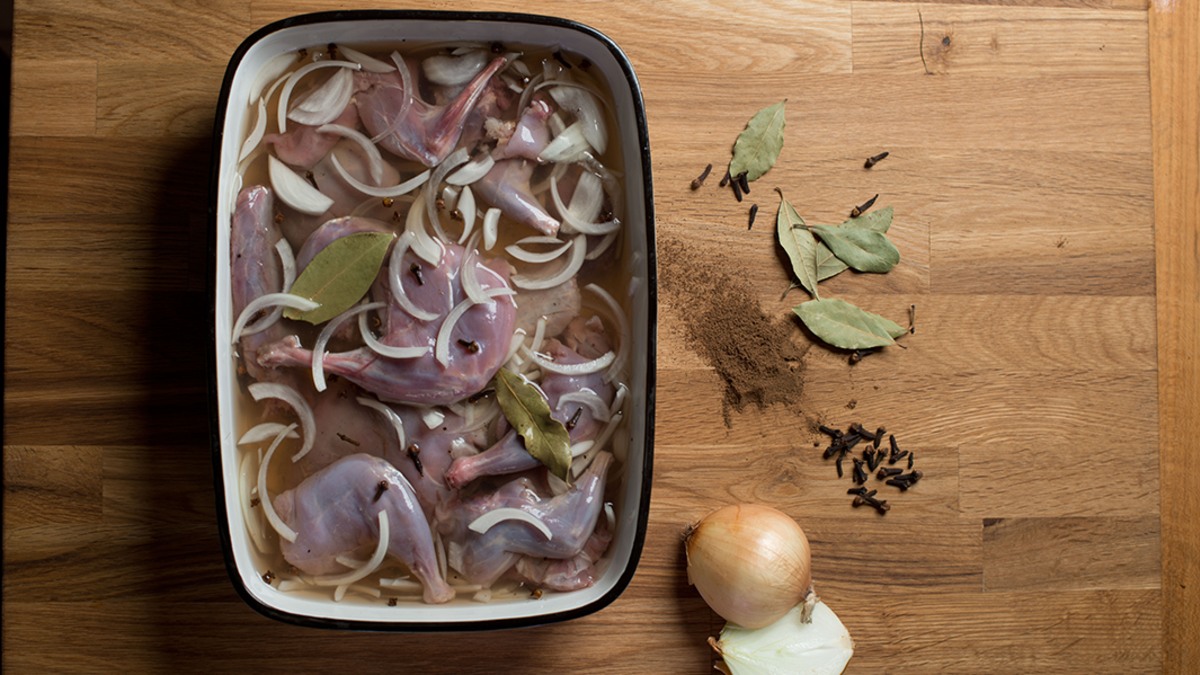
Course
Main
Serves
4
My mom originally got a version of a hasenpfeffer recipe from her mother, who found it on the back of a box containing a frozen domestic rabbit. Growing up, my brothers and I ate countless squirrels and rabbits prepared in this fashion, and it remains one of our favorite small game preparations today.
I’ve made a few changes to the recipe over the years, particularly to tone down the vinegar and to thicken the sauce. It still serves as a pleasant and vivid reminder of chasing small game with my brothers.
If you know someone who’s reluctant to try squirrel, this timeless classic is likely to change their mind.
Ingredients
- 4 squirrels or 2 rabbits, skinned and cut into 4 legs and 2 loins each (about 2 pounds total)
- 1-1/2 cups cider vinegar
- 1 tsp. whole cloves
- 3 bay leaves
- 1 medium onion, peeled and sliced
- 2 tsp. kosher salt
- 2 tsp. sugar
- 1/4 tsp. freshly ground black pepper
- 1/8 tsp. allspice
- Vegetable oil for cooking
- 1/2 cup flour
- 3 cups low-sodium chicken stock
- 5 or 6 gingerbread cookies, crushed (about 1/2 cup)
Preparation
- Make a brine by combining the vinegar, cloves, bay leaves, onion, salt, sugar, pepper, and allspice.
- Place the meat in a food-safe tub, pour the brine over, and set a heavy plate on top of the meat to keep it submerged.
- Refrigerate for two or three days.
- When ready to cook, remove the meat and pat it dry with paper towels. Reserve l cup of the leftover brine and discard the rest. Heat 1/4 inch oil in a large heavy-bottomed pot or Dutch oven over medium-high heat.
- Dredge the meat in the flour. Working in batches, brown the meat in the hot oil. Remove the meat to a plate and set aside.
- Drain the excess oil and return the meat to the pot, arranging it in a single layer. Add the stock and the reserved 1 cup brine; it should be enough to just barely cover the meat.
- Bring to a boil. Lower the heat, skim off and discard any scum, and simmer for 1-1-1/2 hours until the meat is tender but is not falling off the bone. Squirrel and rabbit have different cooking times. Rabbit joints will become flexible at the point of doneness. Both types of meat are done when they no longer spring back when pressed with your finger or a fork.
- Remove the meat and set aside.
- Thicken the remaining liquid in the pan with the crushed gingersnaps. Return the meat to the thickened sauce to warm through.
- Serve over a bed of mashed potatoes.
Sign In or Create a Free Account
My mom originally got a version of a hasenpfeffer recipe from her mother, who found it on the back of a box containing a frozen domestic rabbit. Growing up, my brothers and I ate countless squirrels and rabbits prepared in this fashion, and it remains one of our favorite small game preparations today.
I’ve made a few changes to the recipe over the years, particularly to tone down the vinegar and to thicken the sauce. It still serves as a pleasant and vivid reminder of chasing small game with my brothers.
If you know someone who’s reluctant to try squirrel, this timeless classic is likely to change their mind.
Ingredients
- 4 squirrels or 2 rabbits, skinned and cut into 4 legs and 2 loins each (about 2 pounds total)
- 1-1/2 cups cider vinegar
- 1 tsp. whole cloves
- 3 bay leaves
- 1 medium onion, peeled and sliced
- 2 tsp. kosher salt
- 2 tsp. sugar
- 1/4 tsp. freshly ground black pepper
- 1/8 tsp. allspice
- Vegetable oil for cooking
- 1/2 cup flour
- 3 cups low-sodium chicken stock
- 5 or 6 gingerbread cookies, crushed (about 1/2 cup)
Preparation
- Make a brine by combining the vinegar, cloves, bay leaves, onion, salt, sugar, pepper, and allspice.
- Place the meat in a food-safe tub, pour the brine over, and set a heavy plate on top of the meat to keep it submerged.
- Refrigerate for two or three days.
- When ready to cook, remove the meat and pat it dry with paper towels. Reserve l cup of the leftover brine and discard the rest. Heat 1/4 inch oil in a large heavy-bottomed pot or Dutch oven over medium-high heat.
- Dredge the meat in the flour. Working in batches, brown the meat in the hot oil. Remove the meat to a plate and set aside.
- Drain the excess oil and return the meat to the pot, arranging it in a single layer. Add the stock and the reserved 1 cup brine; it should be enough to just barely cover the meat.
- Bring to a boil. Lower the heat, skim off and discard any scum, and simmer for 1-1-1/2 hours until the meat is tender but is not falling off the bone. Squirrel and rabbit have different cooking times. Rabbit joints will become flexible at the point of doneness. Both types of meat are done when they no longer spring back when pressed with your finger or a fork.
- Remove the meat and set aside.
- Thicken the remaining liquid in the pan with the crushed gingersnaps. Return the meat to the thickened sauce to warm through.
- Serve over a bed of mashed potatoes.




